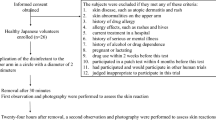Summary
To document deodorant efficacy the antimicrobial activity of a gelatinous antiperspirant formulation of aqueous aluminum chloride hexahydrate was investigated. In vitro assays demonstrated highly bactericidal activity on microorganisms comprising the resident axillary skin flora, including micrococcaceae and aerobic diphtheroid bacteria. Gram-negative bacteria and yeast were partially inhibited. In vivo experiments utilizing occlusive patches on forearm skin and bacterial sampling of the axilla showed pronounced bacteriostasis and persistence of aluminum chloride on the skin. Inhibition of microbial growth lasted more than 3 days after a single treatement of the axilla. Following repeated open applications to the volar aspect of the forearm, the skin remained virtually sterile for 3 days.
Zusammenfassung
Die antimikrobielle Wirkung einer gelatinierten wäßrigen Antiperspirantlösung mit Aluminiumchloridhexahydrat wurde untersucht, um die desodorierende Wirkung zu dokumentieren. In vitro konnte ein hochgradig bakterizider Effekt auf Mikroorganismen der axillären Hautflora, wie Micrococcaceae und aerobe Corynebakterien gezeigt werden. Gram-negative Bakterien und Hefen wurden nur teilweise gehemmt. In-vivo-Experimente bestätigten eine ausgeprägte bakteriostatische Wirkung sowie eine Persistenz von Aluminiumchlorid an der Hautoberfläche. Dies gelang durch Untersuchung der Bakterienflora sowohl in Okklusionsversuchen am Unterarm als auch in der Axilla nach üblicher Antiperspirantanwendung. Nach einer einzigen Behandlung der Axilla dauerte die Wachstumshemmung der Hautflora mehr als 3 Tage an. Nach wiederholter offener Anwendung am volaren Unterarm blieb die Haut über 3 Tage annähernd keimfrei.
Similar content being viewed by others
References
Bandrup F, Larsen PO (1978) Axillary hyperhidrosis. Local treatment with aluminum chloride hexahydrate 25% in absolute ethanol. Acta Derm Venereol (Stockh) 58:461–465
Blank IH, Dawes RK (1960) Antibacterial activity of weak solutions of aluminum salts. Arch Dermatol 81:565–569
Blank IA, Moreland M, Dawes RK (1957) The antibacterial activity of aluminum salts. Cosmetic J 27:32–36
Burow A (1857) Über die Wirkung der essigsauren Tonerde in verschiedenen Krankheiten. Dtsch Klinik 9:147–148, 155–158
Graber W (1977) Eine einfache, wirksame Behandlung der axillären Hyperhidrose. Schweiz Rundschau Med 66:1080–1084
Hölzle E (1981) Wirkungsmechanismus und therapeutische Anwendung der Antiperspirantien vom Typ der Metallsalze. Hautarzt, Supplement V, 32:436–437
Hölzle E, Kligman AM (1978) The pathogenesis of miliaria rubra. Role of the resident microflora. Br J Dermatol 99:117–137
Hölzle E, Kligman AM (1979) Mechanism of anti-perspirant action of aluminum salts. J Soc Cos Chem 30:279–295
Hölzle E, Labows J, McGinley KJ, Leyden JJ, Kligman AM (1978) Quantitative and qualitative studies on axillary microflora, sebum, apocrine and eccrine sweating in relationship to odor. Poster exhibit, 37th annual meeting of the AAD, San Francisco
Hurley HJ, Shelley WB (1978) Special topical approach to the treatment of acne. Suppression of sweating with aluminum chloride in an anhydrous formulation. Cutis 22:696–703
Leyden JJ, Kligman AM (1975) Aluminum chloride in the treatment of symptomatic athlete's foot. Arch Dermatol 111:1004–1010
Leyden JJ, McGinley KJ, Hölzle E, Labows JN, Kligman AM (1981) The microbiology of the human axilla and its relationship to axillary odor. J Invest Dermatol 77:413–416
Lyon I, Klotz IM (1958) The interaction of epidermal protein with aluminum salts. J Am Pharm Assoc 47:509–512
Marples RR, Kligman AM (1974) Methods for evaluating topical antibacterial agents on human skin. Antimicr Agents Chemother 5:323–329
Scholes KT, Crow KD, Ellis JP, Harmann RR, Saihan EM (1978) Axillary hyperhidrosis treated with alcoholic solution of aluminum chloride hexahydrate. Br Med J 78/2:84–85
Shelley WB, Hurley HJ (1975) Studies on topical antiperspirant control of axillary hyperhidrosis. Acta Derm Venereol (Stockh) 55:241–260
Shelley WB, Hurley HJ (1980) Anhydrous formulation of aluminum chloride for chronic folliculitis. JAMA 244:1956–1957
Shelley WB, Hurley HJ, Nichols AL (1953) Axillary odor: Experimental study of role of bacteria, apocrine sweat and deodorants. Arch Dermatol Res 68:430–446
Stillians AW (1916) The control of localized hyperhidrosis. JAMA 67:2015
Williamson P, Kligman AM (1965) A new method for the quantitative investigation of cutaneous bacteria. J Invest Dermatol 45:498–503
Author information
Authors and Affiliations
Rights and permissions
About this article
Cite this article
Hölzle, E., Neubert, U. Antimicrobial effects of an antiperspirant formulation containing aqueous aluminum chloride hexahydrate. Arch Dermatol Res 272, 321–329 (1982). https://doi.org/10.1007/BF00509063
Issue Date:
DOI: https://doi.org/10.1007/BF00509063




